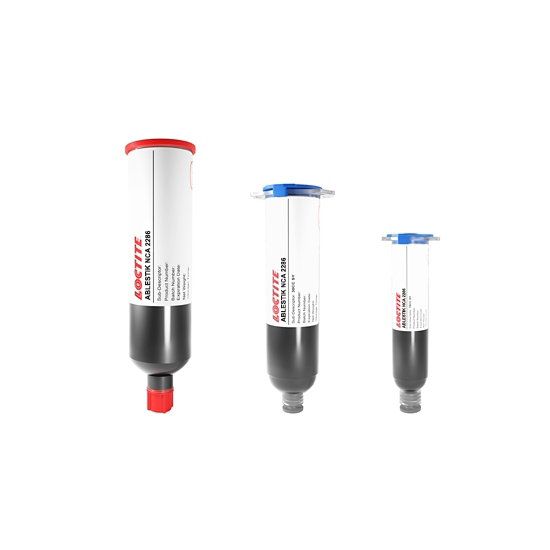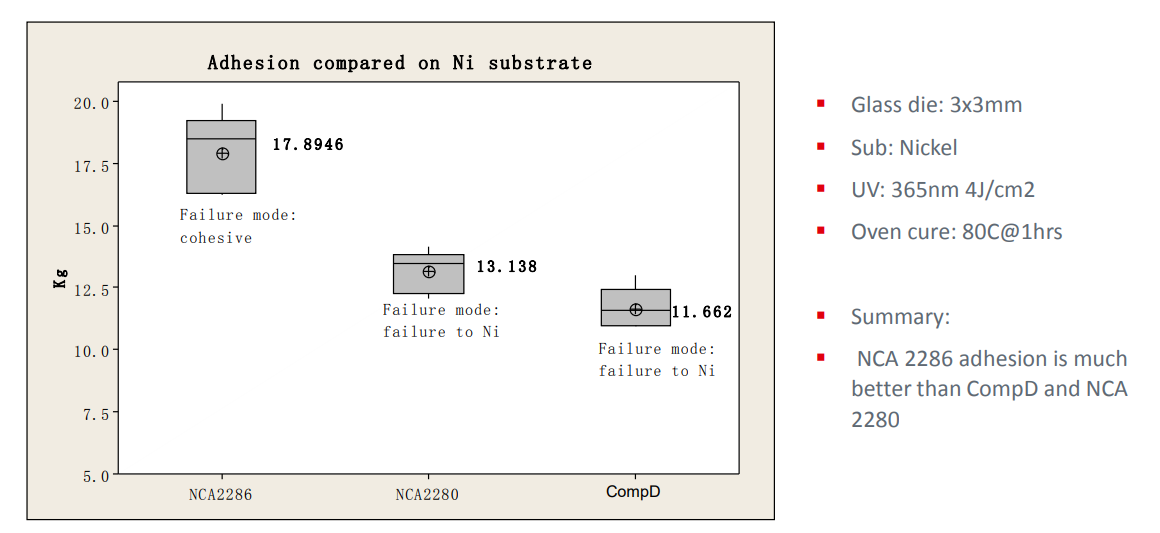LOCTITE ABLESTIK NCA 2286
- Dual Cure
- High elongation strength
- Active alignment in lens holder attach
Product Description
LOCTITE ABLESTIK NCA 2286 dual cure acrylic adhesive is designed for use in active alignment applications in camera module assembly. It has been formulated to a high viscosity and thixotropy to enable higher aspect ratios of dispensed adhesive, thus allowing for easier adjustments for the final assembly. This material jas a very high dispense aspect ration and is engineered to meet the high reliability performance requirements for the optoelectronic / semiconductor industry.
LOCTITE ABLESTIK NCA 2286 is black in color to prevent light penetration into the final assembled device. It is designed to achieve fast cure response at low temperatures and good depth of cure after UV radiation. This product also contains a secondary thermal cure mechanism for applications with shadowed areas where light is unable to penetrate. It is a camera/sensor market material that is not expected to pass very harsh reliability requirements.
Cure Schedule
UV Light
- UV Wavelength, nm 220 to 380
- Light Intensity, mW/cm² 1,000
- Exposure Time, seconds 4
Secondary Heat Cure
- 1 hour @ 80°C
Technical Specifications
| General Properties | |||||||
| |||||||
| Thermal Properties | |||||||
| Glass Transition Temperature (Tg) Glass Transition Temperature (Tg) The glass transition temperature for organic adhesives is a temperature region where the polymers change from glassy and brittle to soft and rubbery. Increasing the temperature further continues the softening process as the viscosity drops too. Temperatures between the glass transition temperature and below the decomposition point of the adhesive are the best region for bonding. The glass-transition temperature Tg of a material characterizes the range of temperatures over which this glass transition occurs. | 28 °C | ||||||
| |||||||
| Mechanical Properties | |||||||
| Elongation Elongation Elongation is the process of lengthening something. It is a percentage that measures the initial, unstressed, length compared to the length of the material right before it breaks. It is commonly referred to as Ultimate Elongation or Tensile Elongation at break. | 60 % | ||||||
| |||||||
| Physical Properties | |||||||
| Thixotropic index Thixotropic index Thixotropic Index is a ratio of a material s viscosity at two different speeds in Ambient temperature, generally different by a factor of ten. A thixotropic material s viscosity will decrease as agitation or pressure is increased. It indicates the capability of a material to hold its shape. Mayonnaise is a great example of this. It holds its shape very well, but when a shear stress is applied, the material easily spreads. It helps in choosing a material in accordance to the application, dispense method and viscosity of a material. | 5.7 | ||||||
| Viscosity Viscosity Viscosity is a measurement of a fluid’s resistance to flow. Viscosity is commonly measured in centiPoise (cP). One cP is defined as the viscosity of water and all other viscosities are derived from this base. MPa is another common unit with a 1:1 conversion to cP. A product like honey would have a much higher viscosity -around 10,000 cPs- compared to water. As a result, honey would flow much slower out of a tipped glass than water would. The viscosity of a material can be decreased with an increase in temperature in order to better suit an application | 40,000 mPa.s | ||||||





